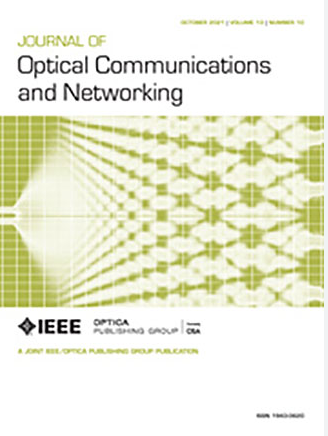支持自主光网络的光子设备可编程性
IF 4
2区 计算机科学
Q1 COMPUTER SCIENCE, HARDWARE & ARCHITECTURE
引用次数: 0
摘要
随着收发器、放大器、多路复用器或 ROADM 等可编程光设备的出现和整合,这些设备可通过采用软件定义网络原则(如模型驱动开发)进行远程配置和控制,从而使网络逐渐向更加自主的方向发展。这种网络利用设备的可编程性,能够适应流量和网络条件的变化并做出反应,例如改变运行模式或重新配置网络状态,为更多地采用人工智能/ML 模型支持增强型网络运行铺平了道路。在本文中,我们简要回顾了光网络控制和协调系统中支持自主组网的一些关键要素,然后详细介绍了收发器运行模式自主闭环动态适应的概念验证。这包括:(i) 基于扩展的 OpenConfig 终端设备数据模型,设计和开发多频段可切片带宽可变收发器的 SDN 代理;(ii) SDN 控制器,用于发现和管理收发器的运行模式,并映射到传输 API(TAPI)配置文件,从而实现高效的物理层损伤感知路径计算;(iv) 基于 MQTT 的遥测平台,用于控制平面功能实体之间基于发布者/订阅者的状态同步,以避免系统性轮询。本文章由计算机程序翻译,如有差异,请以英文原文为准。
Photonic device programmability in support of autonomous optical networks
The emergence and consolidation of increasingly programmable optical devices such as transceivers, amplifiers, multiplexers, or ROADMs—which allow their remote configuration and control by adopting software-defined networking principles such as model-driven development—is enabling the evolution toward gradually more autonomous networks. Such networks leverage device programmability and are able to adapt and react to traffic and network condition changes, e.g., changing modes of operation or reconfiguring the network state, paving the way for the increased adoption of AI/ML models in support of enhanced network operation. In this paper, after a short review of some key elements in the control and orchestration systems of optical networks in support of autonomous networking, we present in detail a proof-of-concept validation of autonomous, closed-loop dynamic adaptation of transceiver operational modes. This includes (i) the design and development of an SDN agent of a multi-band sliceable bandwidth variable transceiver, based on extended OpenConfig terminal device data models; (ii) an SDN controller that performs discovery and management of transceivers’ operational modes and maps to transport API (TAPI) profiles enabling efficient physical layer impairment-aware path computation; (iii) a dedicated externalized path computation element/digital twin that performs adaptation recommendations; and (iv) an MQTT-based telemetry platform for publisher/subscriber based state synchronization between the control plane functional entities to avoid systematic polling.
求助全文
通过发布文献求助,成功后即可免费获取论文全文。
去求助
来源期刊
CiteScore
9.40
自引率
16.00%
发文量
104
审稿时长
4 months
期刊介绍:
The scope of the Journal includes advances in the state-of-the-art of optical networking science, technology, and engineering. Both theoretical contributions (including new techniques, concepts, analyses, and economic studies) and practical contributions (including optical networking experiments, prototypes, and new applications) are encouraged. Subareas of interest include the architecture and design of optical networks, optical network survivability and security, software-defined optical networking, elastic optical networks, data and control plane advances, network management related innovation, and optical access networks. Enabling technologies and their applications are suitable topics only if the results are shown to directly impact optical networking beyond simple point-to-point networks.

 求助内容:
求助内容: 应助结果提醒方式:
应助结果提醒方式:


